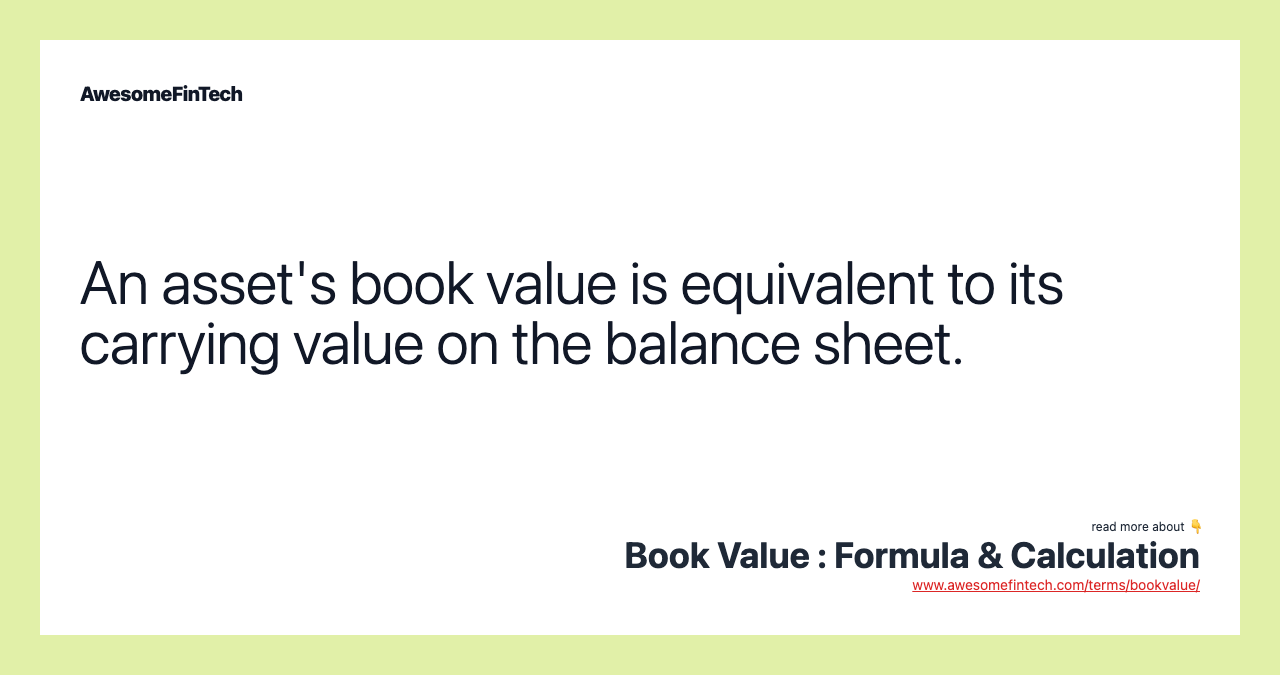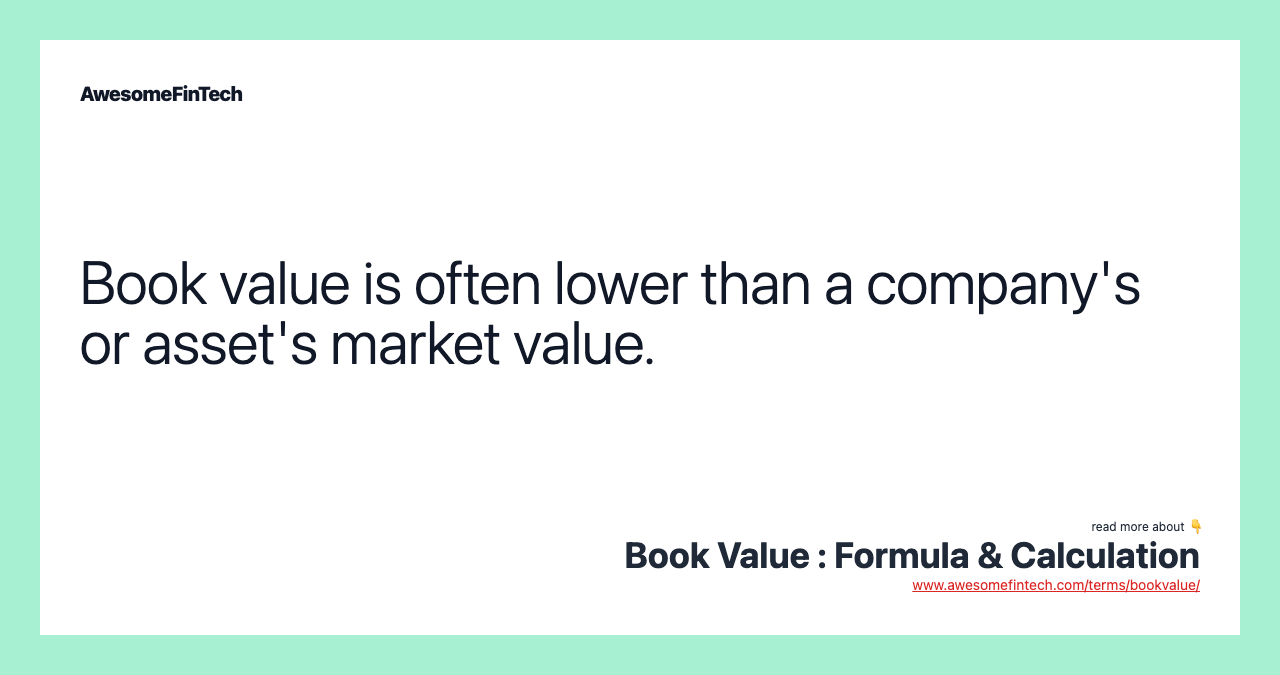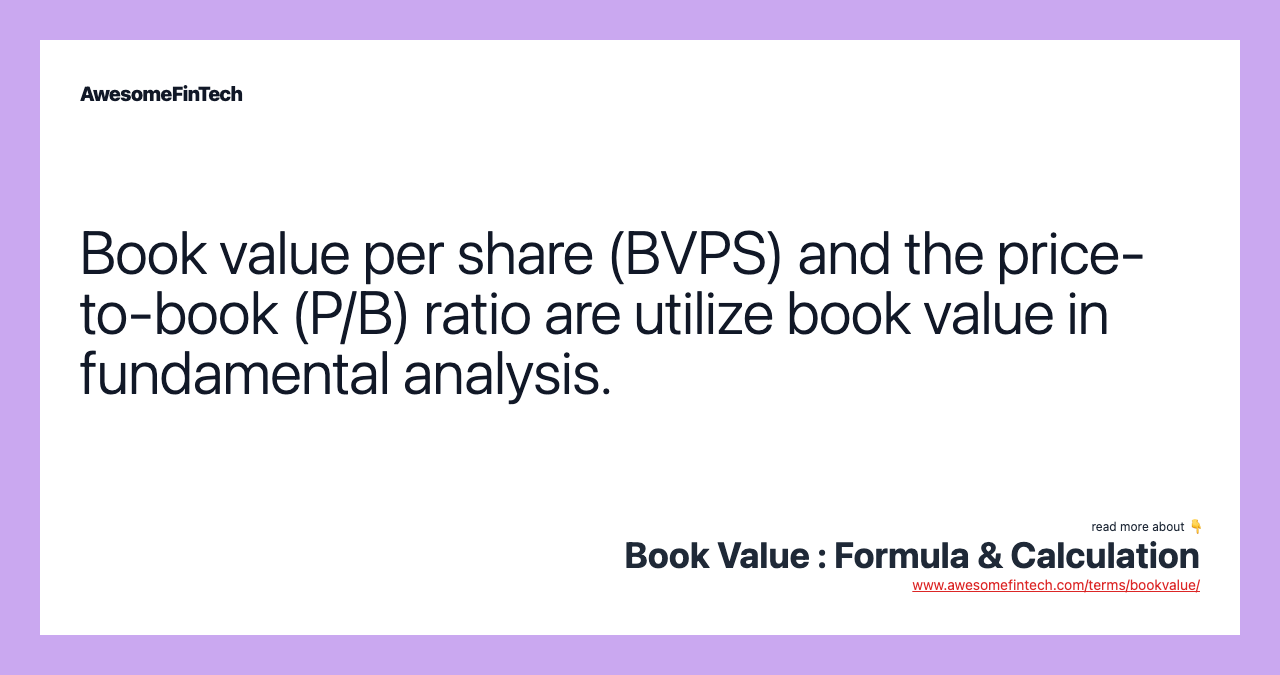Book Value : Formula & Calculation
Book value is equal to the cost of carrying an asset on a company's balance sheet, and firms calculate it netting the asset against its accumulated depreciation. As the accounting value of a firm, book value has two main uses: 1. It serves as the total value of the company's assets that shareholders would theoretically receive if a company was liquidated. 2. When compared to the company's market value, book value can indicate whether a stock is under- or overpriced. The book value of a company is the net difference between that company's total assets and total liabilities, where book value reflects the total value of a company's assets that shareholders of that company would receive if the company were to be liquidated. Since a company's book value represents the shareholding worth, comparing book value with the market value of the shares can serve as an effective valuation technique when trying to decide whether shares are fairly priced. Book value per share (BVPS) is a method to calculate the per-share book value of a company based on common shareholders' equity in the company.

What Is Book Value?
Book value is equal to the cost of carrying an asset on a company's balance sheet, and firms calculate it netting the asset against its accumulated depreciation. As a result, book value can also be thought of as the net asset value (NAV) of a company, calculated as its total assets minus intangible assets (patents, goodwill) and liabilities. For the initial outlay of an investment, book value may be net or gross of expenses such as trading costs, sales taxes, service charges, and so on.
The formula for calculating book value per share is the total common stockholders' equity less the preferred stock, divided by the number of common shares of the company. Book value may also be known as "net book value" and, in the U.K., "net asset value of a firm."




Understanding Book Value
Book value is the accounting value of the company's assets less all claims senior to common equity (such as the company's liabilities). The term book value derives from the accounting practice of recording asset value at the original historical cost in the books.
While the book value of an asset may stay the same over time by accounting measurements, the book value of a company collectively can grow from the accumulation of earnings generated through asset use. Since a company's book value represents the shareholding worth, comparing book value with the market value of the shares can serve as an effective valuation technique when trying to decide whether shares are fairly priced.
As the accounting value of a firm, book value has two main uses:
- It serves as the total value of the company's assets that shareholders would theoretically receive if a company was liquidated.
- When compared to the company's market value, book value can indicate whether a stock is under- or overpriced.
Book value per share (BVPS) is a method to calculate the per-share book value of a company based on common shareholders' equity in the company. Should the company dissolve, the book value per common share indicates the dollar value remaining for common shareholders after all assets are liquidated and all debtors are paid. If a company’s BVPS is higher than its market value per share, then its stock may be considered to be undervalued.
In personal finance, the book value of an investment is the price paid for a security or debt investment. When a company sells stock, the selling price minus the book value is the capital gain or loss from the investment.
Mark to Market Valuation
There are limitations to how accurately book value can be a proxy to the shares' market worth when mark to market valuation is not applied to assets that may experience increases or decreases of their market values.
For example, real estate owned by a company may gain in market value at times, while its old machinery can lose value in the market because of technological advancements. In these instances, book value at the historical cost would distort an asset or a company's true value, given its fair market price.
Price-to-Book Ratio
Price-to-book (P/B) ratio as a valuation multiple is useful for value comparison between similar companies within the same industry when they follow a uniform accounting method for asset valuation. The ratio may not serve as a valid valuation basis when comparing companies from different sectors and industries whereby some companies may record their assets at historical costs and others mark their assets to market.
As a result, a high P/B ratio would not necessarily be a premium valuation, and conversely, a low P/B ratio would not automatically be a discount valuation.
Related terms:
Accumulated Depreciation
Accumulated depreciation is the cumulative depreciation of an asset up to a single point in its life. read more
Book
A book is a record of all the positions that a trader is holding, showing the quantity of longs and shorts in each security. read more
Book Value Per Common Share - BVPS
Book value per common share (BVPS) derives a company's book value on a per-share basis. read more
Book Value Per Share (BVPS)
Book value per share (BVPS) measures a company's book value on a per-share basis. read more
Capital Gain
Capital gain refers to an increase in a capital asset's value and is considered to be realized when the asset is sold. read more
Graham Number
The Graham number is the upper bound of the price range that a defensive investor should pay for a stock. read more
Intangible Asset & Example
An intangible asset is an asset that is not physical in nature and can be classified as either indefinite or definite. read more
Liquidation Value
Liquidation value is the total worth of a company's physical assets if it were to go out of business. The liquidation value is the value of company real estate, fixtures, equipment, and inventory. read more
Market Value
Market value is the price an asset gets in a marketplace. Market value also refers to the market capitalization of a publicly traded company. read more
Mark to Market (MTM) Accounting
Mark to market (MTM) is a method of measuring the fair value of accounts that can fluctuate over time, such as assets and liabilities. read more